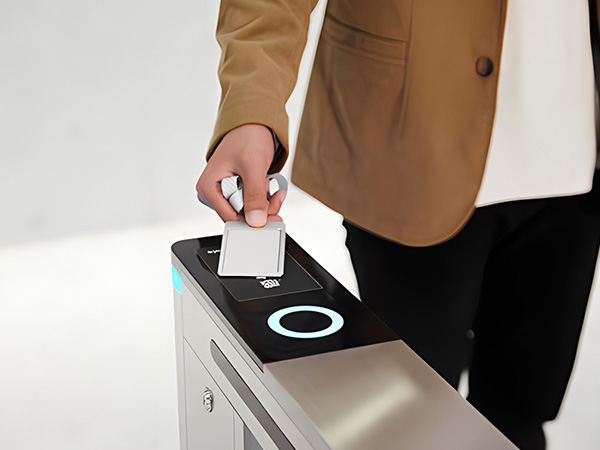You might not realize it, but many everyday items rely on a tiny, battery-free tech wonder: RFID tags. Think about the anti-theft labels on supermarket snacks, the checkout cards for library books, the tracking chips on delivery packages, or even the ID tags on your pet’s collar—none of these RFID tags have a battery. Yet, they can be “woken up” from a distance by a reader and send data back! How does this seemingly impossible trick work? And what sets passive RFID apart from active RFID? Let’s break down this amazing “no-power operation” technology.
1. Where Does a Passive RFID Tag Get Its “Power”?
At its heart, RFID (Radio Frequency Identification) is all about wireless communication. Here’s the key: the RFID reader sends out radio waves at a specific frequency. These waves act like “energy messengers”—they don’t just carry instructions to the tag; they also “charge” the tag’s chip so it can function.RFID systems are split into three types based on whether the tag has a built-in battery: passive, active, and semi-active. When it comes to saving power (or rather, using no power at all), passive RFID is in a league of its own—it’s the ultimate “energy saver.”
2. Passive RFID: No Battery, Just “Harvesting Power” to Work!
A passive RFID tag has an ultra-simple design: no battery, just a tiny chip (which stores data) and a thin antenna (to pick up signals). When the tag gets near an RFID reader, something clever happens: the radio waves from the reader (usually low-frequency 125KHz, high-frequency 13.56MHz, or ultra-high-frequency 860-960MHz) interact with the tag’s antenna. The antenna converts the energy from these waves into electricity—like a mini wireless charger for the chip!Once the chip is activated, it immediately sends the stored information (such as a product’s unique ID or access control permissions) back to the reader via radio waves. That’s how the whole identification process wraps up in seconds.
✅ Key Benefits:
· Battery-free: It draws all its power from the reader’s radio waves, so its lifespan is practically endless. As long as the chip doesn’t break, it can work for decades!
· Low cost: With a simple structure and no battery parts, passive tags usually cost just a few cents to a few dollars. This makes them perfect for large-scale use—like tagging every item in a supermarket or every book in a library.
· Small and light: These tags can be made as small as a coin or even thinner. When attached to product packaging, clothing labels, or pet collars, they add no extra bulk.
· No maintenance needed: Since there’s no battery to replace, you won’t spend a penny on upkeep over time.
❌ Minor Downsides:
· Short read/write range: Most passive tags (low or high frequency) only work within a few centimeters to a few meters. Ultra-high-frequency passive tags can reach up to around 10 meters, but their signal is easily disrupted by metal objects and liquids.
· Limited data storage: They usually hold just a few hundred bytes of data—enough for an ID number or basic info, but not for large files or images.
 RFID Tag
RFID Tag
 HF RFID Tag
HF RFID Tag
 UHF RFID Tag
UHF RFID Tag
 RFID Labels or Sticker
RFID Labels or Sticker
 UHF RFID Labels or Sticker
UHF RFID Labels or Sticker
 RFID Epoxy Tag
RFID Epoxy Tag
 RFID Tag Card
RFID Tag Card
 RFID Ear Tag
RFID Ear Tag
 RFID Laundry Tag
RFID Laundry Tag
 RFID Cable Tie Tag
RFID Cable Tie Tag
 RFID Tire Tag
RFID Tire Tag
 RFID Clothes Tag
RFID Clothes Tag
 RFID Jewelry Tag
RFID Jewelry Tag
 Anti Metal Rfid Tag
Anti Metal Rfid Tag
 RFID Nail Tag
RFID Nail Tag
 RFID Screw Tag
RFID Screw Tag
 Embedded RFID Tag
Embedded RFID Tag
 Ceramic RFID Tag
Ceramic RFID Tag
 Flexible RFID Tag
Flexible RFID Tag
 Special Tag
Special Tag
 HF ABS Tag
HF ABS Tag
 UHF ABS Tag
UHF ABS Tag
 ABS Anti-metal Tag
ABS Anti-metal Tag
 HF PCB Anti-metal Tag
HF PCB Anti-metal Tag
 UHF PCB Anti-metal Tag
UHF PCB Anti-metal Tag
 UHF PPS Tag
UHF PPS Tag
 HF PPS Tag
HF PPS Tag
 HF FPC Tag
HF FPC Tag
 Industry Application Tag
Industry Application Tag
 RFID Tags For Warehouse
RFID Tags For Warehouse
 RFID Tags For Asset
RFID Tags For Asset
 RFID Tags For Apparel
RFID Tags For Apparel
 RFID Tags For Laundry
RFID Tags For Laundry
 RFID Tags For Books
RFID Tags For Books
 RFID Tags For Patrol
RFID Tags For Patrol
 RFID Tags For Animals
RFID Tags For Animals
 EN
EN


























 英语
英语




